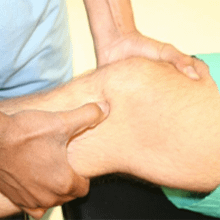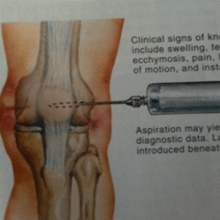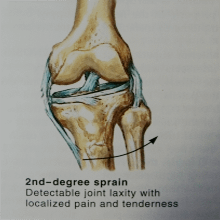SKIING KNEE INJURIES
Knee injuries are all too common among skiers, young and old, novice to expert.
Winter is your favorite season. Cold temperatures mean deep snow on the mountain slopes. You have been training all off season. You are fit and lean. Your gear is tuned and it is time to head up there. It is ski season, your season.
Knee injuries are all too common among skiers, young and old, novice to expert. Typically knee ski injuries happen to those a touch out of shape, at the end of a hard day of skiing, or to the elite skiers that like steep and fast. Now bad fortune has come down on you while up on the mountain. The Ski Patrol came to your aid and took you on the toboggan ride down to the first aid station.
You are here on the web, searching, trying to learn about your knee injury. What comes next? What path do you need to take to get back to skiing again? Will it be this season or next? Should you sell your gear and give up this sport for which you are passionate? You are the skier with a knee injury and here are several explanations as to what just happened to your injured knee and how Advanced Knee Care can get you back on your mountain top.


TORN ACL (ANTERIOR CRUCIATE LIGAMENT)
A skiing knee injury that causes the knee to twist or bend too far, are accompanied by a pop or two, hurt a lot, swell up fast, and drop you in the snow. This is almost always due to a complete tear of the ACL, the most important knee ligament. ACL tears are a major knee injury that should be evaluated within the week by an Orthopedic Surgeon (do not squander your effort or money with urgent care or ER).
Treatment For A Torn ACL anterior-cruciate-ligament knee doctors usually diagnose ACL tears based on history, physical exam and normal knee x-rays. Most often, the knee is not “too swollen” to examine. Physical findings in a knee with an acute ACL tear include large hemarthrosis, limited flexion and extension, positive lachman test (see image at right), and medial or lateral joint line tenderness. MRI scan (3T high resolution preferred) will confirm the tear and delineate associated injury such as lateral bone bruise, meniscal tear, and condition of the 3 other knee ligaments.
Initial treatment includes RICE (rest, ice, compression, elevation), crutches, +/- knee brace and exercises to regain full knee motion. If a knee is markedly swollen the blood is drained from the knee at the time of the first office visit to diminish knee pain. Aleve or Advil are advised. Sometimes narcotic pain pills are needed.
All athletes require surgical reconstruction of a torn ACL resulting from a skiing knee injury. Return to skiing is variable, usually 6 months to 1 year, sometimes with a protective knee brace. Here is a detailed surgical explanation on how we treat a torn ACL whether from a skiing knee injury or any other kind of knee injury.
MCL (MEDIAL COLLATERAL LIGAMENT)
Medial Collateral Ligament sprain: A simple sprain which causes knee pain from a skiing accident is most often a sprain of the MCL. These skiing knee injuries heal in 4-8 weeks and do not require prolonged bracing or surgery. Self directed exercises or formal physical therapy is the cornerstone of treatment. This injury is treated at Urgent Care, Primary Care or an Orthopedic Surgeon. An MCL sprain occurs from a moderate, excessive twist or blow to the outside of the knee. No pop, pain not severe, mild to no swelling, and often times skiiers can still get down the slope with care. You may need to use crutches and a knee brace for a few days or possibly not and a physical exam will be mostly normal with tenderness localized over the ligament on the medial knee. X-ray is normal, MRI is optional or not needed. Return to skiing without limitations or residual and no brace is expected in 1-3 months, depending on severity of sprain.


MENISCAL TEAR
Meniscal tears do not prevent a skiier from skiing but due to the knee pain with twisting or squatting and swelling of the knee the skiiers performance will be compromised. Eventually a skiier tires of knee pain while skiing and visits a knee surgeon for arthroscopic surgery to fix the problem. For healthy Skiiers under age 55 surgery is curative and return is 1-4 weeks without limitation or future knee problems.
KNEE CAP DISLOCATION (PATELLAR INSTABILITY)
What causes kneecap dislocation while skiing? This injury is the least common of the 4 injuries detailed in this report. Kneecap (patella) dislocation, or patellar subluxation, occurs when the triangle-shaped bone covering the knee (patella) moves out of place. This is a common occurrence in young athletes, especially females.
Most commonly, the kneecap (patella) dislocates due to a twisting stress to the knee. However, the injury can also occur because of direct contact. If a sudden twisting movement or rapid change in direction occurs, the stress to the knee can cause the kneecap to shift out of place. For example, if a skiier suddenly changes directions, the force can lead to patellar subluxation or dislocation.
This injury should be treated by a knee surgeon. Treatment is highly variable dependent on many factors. Physical therapy, bracing, and surgery are all options depending on the frequency and severity of the problem. Successful treatment allows skiiers to return to the slopes.

Ready to Schedule a Consultation?
Get started today by completing our request form. If you have additional questions, contact us by phone or e-mail, and our trained staff will assist you to the best of our ability or have Dr. Tarlow address your question when appropriate.
